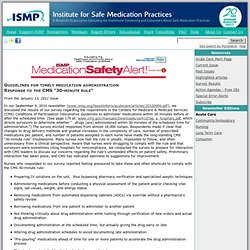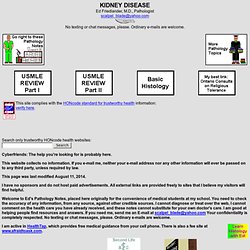

Hyperkalemia and other electrolytes disorders.
Critical Care Nursing. Databases and Journals. Nursing concerns Pt safety flowchart. Nursing Concerns: oral medications that can't be crushed. Guidelines for timely medication administration. From the January 13, 2011 issue In our September 9, 2010 newsletter (www.ismp.org/Newsletters/acutecare/articles/20100909.pdf), we discussed the results of our survey regarding the requirement in the Centers for Medicare & Medicaid Services (CMS) Conditions of Participation Interpretive Guidelines to administer medications within 30 minutes before or after the scheduled time.

(See page 175 at: www.cms.gov/manuals/Downloads/som107ap_a_hospitals.pdf, which directs surveyors to determine whether “…drugs [are] administered within 30 minutes of the scheduled time for administration.”) The survey elicited responses from almost 18,000 nurses. Respondents made it clear that changes to drug delivery methods and gradual increases in the complexity of care, number of prescribed medications per patient, and number of patients assigned to each nurse have made the long-standing CMS “30-minute rule” troublesome. Guidelines for Timely Administration of Medications. Keeping ECG's Simple: Digoxin and The Heart. Auscultation. Heart and Lung Sounds Training and Reference Guides. Human brain cross sections.
Brain: Atlas of human anatomy with MRI. Published on Sunday 24 August 2008 SECTION: Anatomy of the brain, face, and neck Images and anatomical references In 2009 we decided to redesign the module on the anatomy of the brain based on MRI with axial slices, having received multiple requests from users for coronal and sagittal slices.

Preparation of this new module took more than 6 months, and involved labeling more than 524 structures on 353 MRI images in three different views and on 26 anatomical diagrams. This module is intended for all physicians and non-physicians with an interest in neuroanatomy and medical imaging, and particularly for general practitioners and specialists in neurology, neurosurgery, anatomy and neurosciences, as well as speech pathologists and psychomotor therapists. Anatomy of the encephalon in MRI (axial, coronal and sagittal slices) Cerebral images used for this module on human anatomy Profiling cerebral anatomic zones Several types of profiles were created for both the slices and the 3D images: KIDNEY DISEASE. KIDNEY DISEASE Ed Friedlander, M.D., Pathologist scalpel_blade@yahoo.com No texting or chat messages, please.

Ordinary e-mails are welcome. Cyberfriends: The help you're looking for is probably here. This website collects no information. If you e-mail me, neither your e-mail address nor any other information will ever be passed on to any third party, unless required by law. This page was last modified August 11, 2014.
I have no sponsors and do not host paid advertisements. Welcome to Ed's Pathology Notes, placed here originally for the convenience of medical students at my school. I am active in HealthTap, which provides free medical guidance from your cell phone. I'm still doing my best to answer everybody. Numbers in {curly braces} are from the magnificent Slice of Life videodisk. I am presently adding clickable links to images in these notes. My team: Ed Lulo's Pathology Gallery Bryan Lee's Pathology MuseumDino Laporte: Pathology MuseumTom Demark: Pathology Museum Also:
IHMC CmapServer 5.03.03. Medicine (Stellenbosch UniversitySouth Africa) Nephrology Basic Science Chronic kidney disease Hypokalemia Polycystic kidneys Renal Failure.

IHMC CmapServer 5.03.03.